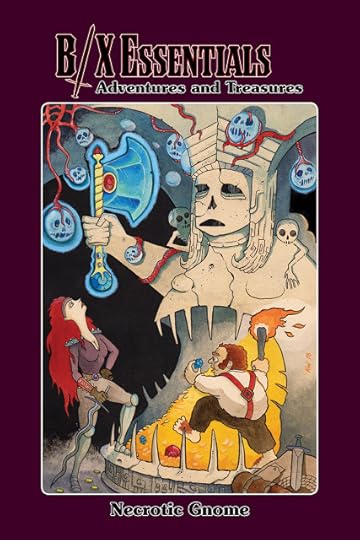Gavin Norman's Blog, page 6
September 19, 2018
B/X Essentials: Classic Set Complete!
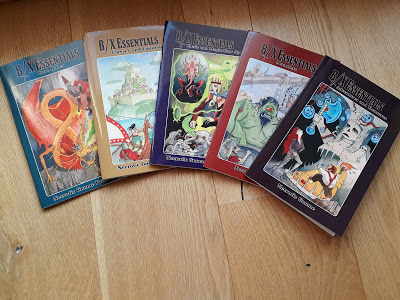
I am delighted to announce the publication of B/X Essentials: Adventures and Treasures! This is the final book in the "classic" B/X Essentials set. Together with the first four books, it forms a complete rules reference to the traditional Basic/Expert game, laid out for enhanced ease of use at the table, and modularised for your house-ruling pleasure.
A true labour of love from myself and the many people who helped out with proofreading, rules checking, number crunching, and so on!
Get it / the whole set here:
Adventures and TreasuresPDF bundle of the complete B/X EssentialsPrint bundle of the complete B/X EssentialsFor more information about the B/X Essentials project, see here.
Published on September 19, 2018 09:15
September 11, 2018
THAC0 in B/X Essentials
Over the last weeks, since the publication of B/X Essentials: Monsters, I've seen some online grumbling about my inclusion of THAC0 in the monster stat blocks. Some people have even gone so far as to say that this makes B/X Essentials incompatible with B/X, thus utterly defeating one of the aims of the project. So I wanted to address this.
To begin with, it's worth restating the aims of the B/X Essentials project:
100% accurate rules clone.Organised for quick reference.Clarified rules.100% Open Game Content.The question of THAC0 lies somewhere between points 1 and 2.
Next up, let's look at an example monster from the B/X Essentials monsters book alongside a monster from the original books.
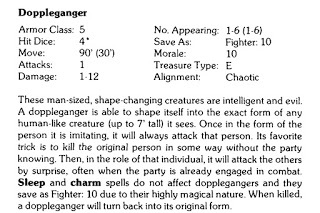 Doppleganger in B/X
Doppleganger in B/X
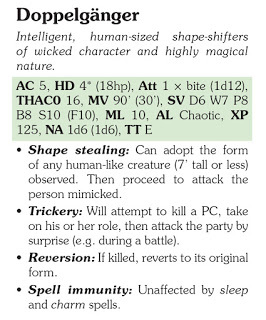 Doppelgänger in B/X Essentials
Doppelgänger in B/X Essentials
Note the differences in the B/X Essentials version:
The average hit points for the HD are listed.The THAC0 is listed.The full set of save values are listed, not merely the class and level that the monster saves as.The pre-calculated XP value is listed.So the stat blocks in B/X Essentials: Monsters are definitely different to traditional B/X stat blocks. They contain extra information. Here's where the second project aim stated above -- “Organised for quick reference” -- comes in. The core B/X Essentials books form a 100% accurate rules reference for B/X, but the way the rules are presented is deliberately different. My aim is to improve the presentation of the rules, making them easier to understand and easier to reference.
Including extra information in the monster stat blocks was done for exactly this reason: to make the monster entries easier to use as a reference during play. Let's look at each of the extra elements:
Average hp: Provided for convenience, either for quick usage instead of rolling for a monster's hit points, or to quickly see whether a rolled hp total is above or below average. The average values are calculated directly from the monster's HD.
THAC0: Provided as an option for referees who prefer to not use the monster attack table from B/X Essentials: Core Rules, thus reducing the need to look up info about a monster across multiple pages. The listed THAC0 values are lifted directly from the monster attack table.
Full saves: Provided in addition to the traditional “save as” value, as an option for referees who prefer to not look up monsters’ saves in the class saving throw tables, thus reducing the need to look up info about a monster across multiple pages. The listed save values are lifted directly from the appropriate class’ saving throw table.
Pre-calculated XP: Provided for convenience to save referees time having to manually calculate XP values by referring to the tables in the core rules,thus reducing the need to look up info about a monster across multiple pages. The listed XP values are calculated directly from the standard monster XP tables.
See the common thread? None of these extras are new information. They simply collate existing information into each monster entry, to reduce the need to flip between different pages looking it up.
I agree that the use of the term THAC0 is open to discussion. I'm aware that it's a term that originated in AD&D, not in B/X, and I thought long and hard about whether to use it or not. In the end, my feeling was that it's a term that most old-school players are already familiar with, so would be less confusing than using a new term. Of course, the meaning of the term is described in the introduction to the book, as well (where it's specifically noted as optional), for the elucidation of anyone who's not familiar with it.
I appreciate that adding extra information to monster stat blocks is a change in presentation, but my feeling is that it's an extremely positive change that makes a real difference to using monster listings in the heat of (imaginary) combat. (Ditto for the changes in the way monster descriptions and special abilities are presented in B/X Essentials: Monsters.)
The really fundamental aim of the B/X Essentials project has always been to improve the presentation of the classic B/X rules. I'm not interested in changing the rules themselves, but I think my fresh presentation of them really adds something to the game.
Hopefully that helps to explain the background to this somewhat spiky, old-school ultra-nerd topic!
May those who like table lookups refer to tables, and may those who like subtraction use THAC0! (And may both types unite against the wicked forces of ascending AC! Haha.)
To begin with, it's worth restating the aims of the B/X Essentials project:
100% accurate rules clone.Organised for quick reference.Clarified rules.100% Open Game Content.The question of THAC0 lies somewhere between points 1 and 2.
Next up, let's look at an example monster from the B/X Essentials monsters book alongside a monster from the original books.
 Doppleganger in B/X
Doppleganger in B/X
 Doppelgänger in B/X Essentials
Doppelgänger in B/X EssentialsNote the differences in the B/X Essentials version:
The average hit points for the HD are listed.The THAC0 is listed.The full set of save values are listed, not merely the class and level that the monster saves as.The pre-calculated XP value is listed.So the stat blocks in B/X Essentials: Monsters are definitely different to traditional B/X stat blocks. They contain extra information. Here's where the second project aim stated above -- “Organised for quick reference” -- comes in. The core B/X Essentials books form a 100% accurate rules reference for B/X, but the way the rules are presented is deliberately different. My aim is to improve the presentation of the rules, making them easier to understand and easier to reference.
Including extra information in the monster stat blocks was done for exactly this reason: to make the monster entries easier to use as a reference during play. Let's look at each of the extra elements:
Average hp: Provided for convenience, either for quick usage instead of rolling for a monster's hit points, or to quickly see whether a rolled hp total is above or below average. The average values are calculated directly from the monster's HD.
THAC0: Provided as an option for referees who prefer to not use the monster attack table from B/X Essentials: Core Rules, thus reducing the need to look up info about a monster across multiple pages. The listed THAC0 values are lifted directly from the monster attack table.
Full saves: Provided in addition to the traditional “save as” value, as an option for referees who prefer to not look up monsters’ saves in the class saving throw tables, thus reducing the need to look up info about a monster across multiple pages. The listed save values are lifted directly from the appropriate class’ saving throw table.
Pre-calculated XP: Provided for convenience to save referees time having to manually calculate XP values by referring to the tables in the core rules,thus reducing the need to look up info about a monster across multiple pages. The listed XP values are calculated directly from the standard monster XP tables.
See the common thread? None of these extras are new information. They simply collate existing information into each monster entry, to reduce the need to flip between different pages looking it up.
I agree that the use of the term THAC0 is open to discussion. I'm aware that it's a term that originated in AD&D, not in B/X, and I thought long and hard about whether to use it or not. In the end, my feeling was that it's a term that most old-school players are already familiar with, so would be less confusing than using a new term. Of course, the meaning of the term is described in the introduction to the book, as well (where it's specifically noted as optional), for the elucidation of anyone who's not familiar with it.
I appreciate that adding extra information to monster stat blocks is a change in presentation, but my feeling is that it's an extremely positive change that makes a real difference to using monster listings in the heat of (imaginary) combat. (Ditto for the changes in the way monster descriptions and special abilities are presented in B/X Essentials: Monsters.)
The really fundamental aim of the B/X Essentials project has always been to improve the presentation of the classic B/X rules. I'm not interested in changing the rules themselves, but I think my fresh presentation of them really adds something to the game.
Hopefully that helps to explain the background to this somewhat spiky, old-school ultra-nerd topic!
May those who like table lookups refer to tables, and may those who like subtraction use THAC0! (And may both types unite against the wicked forces of ascending AC! Haha.)
Published on September 11, 2018 08:02
September 4, 2018
B/X Essentials: Adventures and Treasures -- Spread Preview!
The text for the next B/X Essentials book -- Adventures and Treasures -- is complete. The layout is done, and all illustrations except for a single one are in place.
Now is the traditional time for me to start sharing previews of illustrations and page spreads!
How about this to start with? The table of contents, the foreword, and the first page of the book's content -- the guidelines for choosing an adventure scenario. Enjoy!
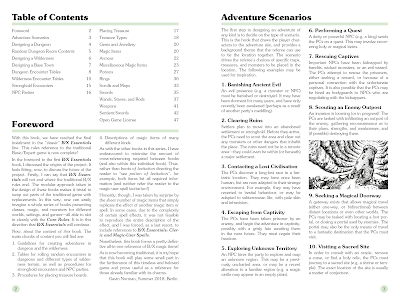 Illustration by Thomas Novosel
Illustration by Thomas Novosel
Now is the traditional time for me to start sharing previews of illustrations and page spreads!
How about this to start with? The table of contents, the foreword, and the first page of the book's content -- the guidelines for choosing an adventure scenario. Enjoy!
 Illustration by Thomas Novosel
Illustration by Thomas Novosel
Published on September 04, 2018 10:04
August 27, 2018
B/X Essentials: Adventures and Treasures: Cover!
Published on August 27, 2018 09:48
August 26, 2018
Regions of the Dolmenwood
In my own Dolmenwood campaign, I've been using a super rough map that divides the forest into different regions. The regions divide the forest up into areas with different characteristics, or with different rulers. Each of these regions will be described in detail, in the Dolmenwood Campaign Book, along with associated encounter tables.
I just knocked up a slightly less rough (ooh! digital!) version of the map to share. Here you go...
 The map is also shared in the Dolmenwood public google drive folder.
The map is also shared in the Dolmenwood public google drive folder.
I just knocked up a slightly less rough (ooh! digital!) version of the map to share. Here you go...
 The map is also shared in the Dolmenwood public google drive folder.
The map is also shared in the Dolmenwood public google drive folder.
Published on August 26, 2018 00:33
August 21, 2018
B/X Essentials: Advanced Characters
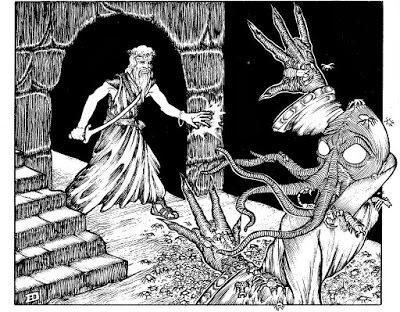 Druid and mindflayer, by Erol Otus
Druid and mindflayer, by Erol OtusAs I've mentioned before, an Advanced Characters book for the B/X Essentials line is in the works. The draft text is finished now, and proofreaders are doing their magic.
I thought it would be worth giving a bit more info as to what exactly is in this book, as it's perhaps a bit different to what people might be expecting. Here's the table of contents:
Foreword.Character Creation.Advanced Character Classes:AcrobatAssassinBarbarianBardDruidIllusionistKnightPaladinRangerAdvanced Demihuman Classes:DrowDuergarGnomeHalf-ElfHalf-OrcSvirfneblinCharacter Races (Optional Rule):DrowDuergarDwarfElfGnomeHalf-ElfHalflingHalf-OrcHumanSvirfneblinSub-Races (Optional Rule):DwarfElfGnomeHalflingAdvanced Equipment:ArmourPoisonWeaponsSome interesting points to note:The assumption of the book is that the new classes in the Advanced Character Classes section (e.g. druids, knights, rangers, etc) are humans.The classes in the Advanced Demihuman Classes seciton are race-classes in the classic B/X style. I'm really pleased with the way these have turned out, and think they'll add a lot of fun to games which use them.There are optional rules for choosing race and class separately, for groups who prefer this, but this approach is explicitly an optional rule. It is not the assumed default of the new material, and was not the primary design goal.I've not included a monk class. I have that earmarked for a future mythic Asian themed book.A lot of previous supplements along similar lines (adding AD&D material to B/X) have been published by others, so I wanted to put my own spin on this. Here's what makes this different to, say, the Labyrinth Lord Advanced Edition Companion:The new classes are much closer to B/X than they are to AD&D. I think previous adaptations have erred more on the side of cloning AD&D material, whereas my renditions are heavily adapted to B/X.The power levels of B/X have been carefully maintained. The maximum level is 14. The new classes are carefully balanced against the standard B/X classes. No d12 Hit Dice for the barbarian. No always-on protection from evil for the paladin.The result is a set of new options for B/X games, rather than a way to play AD&D with the B/X core rules. These are two different things.I've included adaptations of both the core AD&D races/classes and those from Unearthed Arcana. The UA material is more rarely addressed in AD&D / B/X supplements, so I thought it worthy of including. The human classes (acrobat, barbarian, knight) are heavily adapted from the overpowered messes in UA. The demihumans (drow, duergar, svirfneblin) are presented as race-classes (possibly the first time race-classes for these have ever been published?).More news as things develop! I'm in no hurry to publish this book, though. I want to give the new material a proper play test before going ahead.
Published on August 21, 2018 22:56
August 18, 2018
B/X Essentials Print Edition Errata
The first B/X Essentials book was published in September 2017, so nigh on a year ago. Due to the diligent work of the folks who've been helping out with proofreading on these books, very few errors have slipped through, but nonetheless, as few minor mistakes did worm their way into the text.
Following a suggestion of someone on G+, I've compiles a list of errata reported so far. All reported errata is corrected in digital editions (i.e. the online docs and PDFs) as soon as possible. Errata is typically not fixed in the print editions, however, as this requires taking the product down from sale for some weeks. Collected errata will be fixed in future print editions. Inconsequential errata such as typo fixes is not listed.
Here's the doc.
If anyone spots any further mistakes in the text, please let me know!
Following a suggestion of someone on G+, I've compiles a list of errata reported so far. All reported errata is corrected in digital editions (i.e. the online docs and PDFs) as soon as possible. Errata is typically not fixed in the print editions, however, as this requires taking the product down from sale for some weeks. Collected errata will be fixed in future print editions. Inconsequential errata such as typo fixes is not listed.
Here's the doc.
If anyone spots any further mistakes in the text, please let me know!
Published on August 18, 2018 22:48
August 13, 2018
A Meeting of Possums and Gnomes

I was interviewed by intrepid blogger Dungeons and Possums! We talk B/X Essentials, Dolmenwood, and future Necrotic Gnome plans.
https://dungeonspossums.blogspot.com/2018/08/interview-gavin-norman-talks-bx.html
Published on August 13, 2018 09:26
August 2, 2018
On the B/X-ification of Classes
As part of the work on the future B/X Essentials: Advanced Characters book (previously mentioned here), I've found myself reading a lot of AD&D material. With my general B/X obsession, AD&D isn't something I've looked at in great depth for quite some years, so it's been very interesting to observe the contrast between the two rules sets. On the surface, just reading through the class descriptions, the rules are, for the most part, the same, and the level of complexity doesn't seem so much greater. It was when I came to directly comparing the AD&D classes against the B/X classes, though, that the differences stood out rather sharply.
Principles
My aim with the Advanced Characters book is not merely to clone the AD&D material, but to present classes that slot cleanly into B/X. This has several aspects:
Rules: Obviously, the classes must not use any rules that only exist in AD&D (good and evil alignment, for instance). Complexity: The classes must not be any more complex than the existing B/X classes, in terms of the number of class abilities or the mechanical complexity of those abilities. Power: Generally, AD&D amps things up from B/X. The majority of classes have higher HD. Some classes start play with multiple HD. I want my converted classes to be in line with B/X power levels. Rarity: In AD&D, some classes are clearly way more powerful than others. The paladin is a prime example: unlimited use of detect evil, and a continually active protection from evil, 10' radius are the most obvious super-powered class abilities (and both from 1st level!). In order to make classes like this less commonplace, AD&D introduces an additional mechanism: stringent ability score requirements. Only with super lucky rolls can a player select the paladin class, making them exceedingly rare. (This, in turn, was the genesis of the "alternative rolling methods" arms race. But that's another topic.) This concept of class power vs rarity doesn't exist in B/X to anywhere near the same level (the most stringent class requirements are the halfling's CON 9, DEX 9 -- hardly a harsh limitation), so my converted classes should not rely on it. Overlap: Each class should have a clear niche, and its own set of unique abilities. The core B/X classes (especially the core 4 human classes) each have a very clearly defined niche, and can do things that other classes cannot. Adding more classes to the mix, a degree of overlap is inevitably going to creep in, but my aim is to keep this to a minimum, and to make sure that each class retains a niche. There's a tendency in AD&D classes to be able to do everything another class can do, plus X, Y, Z. I want to avoid this.
Practice
With the above in mind, I started writing up some B/X-ified versions of AD&D classes. The question was, though, what exact yardstick to use to ensure that I was achieving the goals I'd set? Eyeballing and play testing are, of course, necessary, but to address the points of complexity and overlap, I quickly came upon a very different, rather unusual, and highly effective method.
One of the prime directives of B/X Essentials is that (as far as possible) all material relating to a topic should appear on the same page or spread. Thus, a very effective measure of the rules-complexity of a topic is simply: how much space does it take up when laid out?
In the basic Classes and Equipment book, the class descriptions have all been painstakingly edited and laid out to fit exactly onto a single page or spread each. For example, the most complex B/X classes (according to the "how much space?" definition of complexity):
 The cleric class -- turn undead requires a lot of explanation
The cleric class -- turn undead requires a lot of explanation
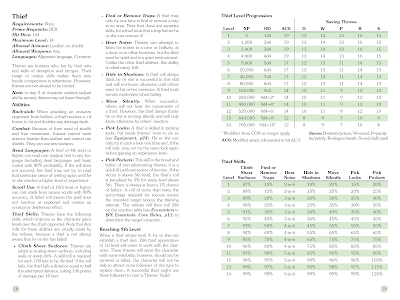 The thief class -- there's a lot of those % skillsSo, if it's possible to fit the whole description of every B/X class onto a single 6" x 9" spread, including all required tables, it should also be possible to fit any new, additional classes within the same space constraints. It was when I started to attempt this that I truly realised how much complexity there is in some of the AD&D classes! Some of them required a huge amount of trimming. But this process of trimming to fit on a spread forced me to consider two things:
The thief class -- there's a lot of those % skillsSo, if it's possible to fit the whole description of every B/X class onto a single 6" x 9" spread, including all required tables, it should also be possible to fit any new, additional classes within the same space constraints. It was when I started to attempt this that I truly realised how much complexity there is in some of the AD&D classes! Some of them required a huge amount of trimming. But this process of trimming to fit on a spread forced me to consider two things:
Which abilities can be simplified? (i.e. so that explaining them takes less words and/or tables.)Which abilities are really the core of this class, and which can be removed?ResultsThus, my aims of complexity and overlap were neatly addressed by this process of rough layout. As a result, I think the classes I'm coming up with are much closer to true B/X-ifications of AD&D material than other, previous attempts at this.
As an example, here's a laid out preview of my B/X-ified paladin class:
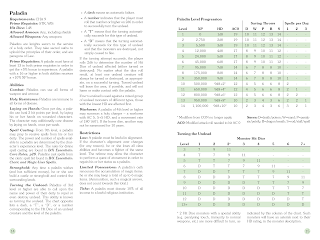
I'll be putting out an official call for play testers soon, but if anyone has any feedback on the paladin, please feel free to comment!
Principles
My aim with the Advanced Characters book is not merely to clone the AD&D material, but to present classes that slot cleanly into B/X. This has several aspects:
Rules: Obviously, the classes must not use any rules that only exist in AD&D (good and evil alignment, for instance). Complexity: The classes must not be any more complex than the existing B/X classes, in terms of the number of class abilities or the mechanical complexity of those abilities. Power: Generally, AD&D amps things up from B/X. The majority of classes have higher HD. Some classes start play with multiple HD. I want my converted classes to be in line with B/X power levels. Rarity: In AD&D, some classes are clearly way more powerful than others. The paladin is a prime example: unlimited use of detect evil, and a continually active protection from evil, 10' radius are the most obvious super-powered class abilities (and both from 1st level!). In order to make classes like this less commonplace, AD&D introduces an additional mechanism: stringent ability score requirements. Only with super lucky rolls can a player select the paladin class, making them exceedingly rare. (This, in turn, was the genesis of the "alternative rolling methods" arms race. But that's another topic.) This concept of class power vs rarity doesn't exist in B/X to anywhere near the same level (the most stringent class requirements are the halfling's CON 9, DEX 9 -- hardly a harsh limitation), so my converted classes should not rely on it. Overlap: Each class should have a clear niche, and its own set of unique abilities. The core B/X classes (especially the core 4 human classes) each have a very clearly defined niche, and can do things that other classes cannot. Adding more classes to the mix, a degree of overlap is inevitably going to creep in, but my aim is to keep this to a minimum, and to make sure that each class retains a niche. There's a tendency in AD&D classes to be able to do everything another class can do, plus X, Y, Z. I want to avoid this.
Practice
With the above in mind, I started writing up some B/X-ified versions of AD&D classes. The question was, though, what exact yardstick to use to ensure that I was achieving the goals I'd set? Eyeballing and play testing are, of course, necessary, but to address the points of complexity and overlap, I quickly came upon a very different, rather unusual, and highly effective method.
One of the prime directives of B/X Essentials is that (as far as possible) all material relating to a topic should appear on the same page or spread. Thus, a very effective measure of the rules-complexity of a topic is simply: how much space does it take up when laid out?
In the basic Classes and Equipment book, the class descriptions have all been painstakingly edited and laid out to fit exactly onto a single page or spread each. For example, the most complex B/X classes (according to the "how much space?" definition of complexity):
 The cleric class -- turn undead requires a lot of explanation
The cleric class -- turn undead requires a lot of explanation The thief class -- there's a lot of those % skillsSo, if it's possible to fit the whole description of every B/X class onto a single 6" x 9" spread, including all required tables, it should also be possible to fit any new, additional classes within the same space constraints. It was when I started to attempt this that I truly realised how much complexity there is in some of the AD&D classes! Some of them required a huge amount of trimming. But this process of trimming to fit on a spread forced me to consider two things:
The thief class -- there's a lot of those % skillsSo, if it's possible to fit the whole description of every B/X class onto a single 6" x 9" spread, including all required tables, it should also be possible to fit any new, additional classes within the same space constraints. It was when I started to attempt this that I truly realised how much complexity there is in some of the AD&D classes! Some of them required a huge amount of trimming. But this process of trimming to fit on a spread forced me to consider two things:Which abilities can be simplified? (i.e. so that explaining them takes less words and/or tables.)Which abilities are really the core of this class, and which can be removed?ResultsThus, my aims of complexity and overlap were neatly addressed by this process of rough layout. As a result, I think the classes I'm coming up with are much closer to true B/X-ifications of AD&D material than other, previous attempts at this.
As an example, here's a laid out preview of my B/X-ified paladin class:

I'll be putting out an official call for play testers soon, but if anyone has any feedback on the paladin, please feel free to comment!
Published on August 02, 2018 22:33
July 30, 2018
B/X Essentials: Downtime
Following on from the announcement of the Post-Apocalyptic book for B/X Essentials, I have another book to announce today:
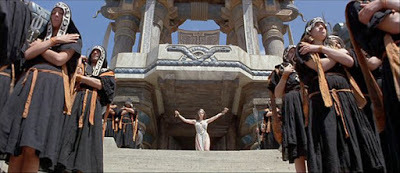
B/X Essentials: DowntimeWritten by Courtney Campbell.
This book is a rules / genre expansion for B/X Essentials that can be used in any fantasy campaign where the group wants to add some more detailed options for the time between adventures.
The traditional Basic/Expert rules largely focus on two things:Adventuring in dungeons.Adventuring in the wilderness.The rules are, however, very sketchy on what characters do in between these two activities, upon returning to the safety of their home town. This book provides loads of options for fun (and profitable!) stuff to do in that period, inspired by Gary Gygax's famous admonishment: “YOU CAN NOT HAVE A MEANINGFUL CAMPAIGN IF STRICT TIME RECORDS ARE NOT KEPT”.
Here's a list of some of the stuff covered:Markets and haggling.Orgies and carousing.City navigation.Locating specialised mercenaries, hirelings, and side-kicks.Optional rules for training.Investments.Arena fights.Theft, crimes, and punishment.Detailed rules for consulting a sage.Gaining influence (political, economic, spiritual, etc).Constructing unique vehicles.Magical labs.The draft text of the book is finished, and I'll be looking for proofreaders to look over it soon!

B/X Essentials: DowntimeWritten by Courtney Campbell.
This book is a rules / genre expansion for B/X Essentials that can be used in any fantasy campaign where the group wants to add some more detailed options for the time between adventures.
The traditional Basic/Expert rules largely focus on two things:Adventuring in dungeons.Adventuring in the wilderness.The rules are, however, very sketchy on what characters do in between these two activities, upon returning to the safety of their home town. This book provides loads of options for fun (and profitable!) stuff to do in that period, inspired by Gary Gygax's famous admonishment: “YOU CAN NOT HAVE A MEANINGFUL CAMPAIGN IF STRICT TIME RECORDS ARE NOT KEPT”.
Here's a list of some of the stuff covered:Markets and haggling.Orgies and carousing.City navigation.Locating specialised mercenaries, hirelings, and side-kicks.Optional rules for training.Investments.Arena fights.Theft, crimes, and punishment.Detailed rules for consulting a sage.Gaining influence (political, economic, spiritual, etc).Constructing unique vehicles.Magical labs.The draft text of the book is finished, and I'll be looking for proofreaders to look over it soon!
Published on July 30, 2018 22:34
Gavin Norman's Blog
- Gavin Norman's profile
- 32 followers
Gavin Norman isn't a Goodreads Author
(yet),
but they
do have a blog,
so here are some recent posts imported from
their feed.


